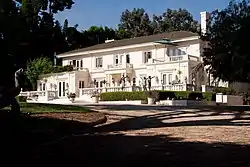Wooded Area, San Diego
32°41′50.19″N 117°14′49.33″W The Wooded Area is a neighborhood within the community of Point Loma, San Diego, California. It encompasses the hilltop area south of Talbot Street on both sides of Catalina Boulevard; the area west of Catalina is also referred to as the College Area. The Wooded Area borders Naval Base Point Loma to the south, La Playa to the east, Roseville-Fleetridge to the north, and Sunset Cliffs and Point Loma Nazarene University to the west. The boundaries of the neighborhood are not universally agreed upon, with different maps showing different borders.[1][2][3]
The Wooded Area gains its name from the large number of Eucalyptus, evergreen, and other trees in the neighborhood. The mature vegetation, along with large lot sizes and lack of sidewalks, contribute to a semi-rural feel.[1] The community is almost entirely residential, except for a small retail center at the corner of Catalina and Talbot streets, and Point Loma Nazarene University at the western edge of the community. Home prices in the area are relatively high and the neighborhood includes several striking mansions, including those built by Reuben H. Fleet,[4] Robert O. Peterson,[5] and Alfred and Marion Robinson.[6]

When Richard Henry Dana Jr. visited San Diego in the 1830s, he described this part of Point Loma as "a well-wooded headland,"[7] where he and the other sailors gathered firewood and hunted rabbits. But the trees and brush were largely cut down for use in the growing town of San Diego, and by 1900 when Katherine Tingley created her Theosophical community Lomaland on the western side of what is now the Wooded Area, the area was completely devoid of trees and shrubs. One of Tingley's supporters described the barren slopes as "this God-forsaken spot."[8] Tingley and her Lomaland community planted numerous orchards and trees throughout the area, particularly eucalyptus and avocado,[9] and are generally credited with creating the "wooded" feel that the area enjoys today.
The Wooded Area was once home to Rosecroft Begonia Gardens, a several-acre begonia garden which was a tourist attraction for several decades.[10] Rosecroft Begonia Gardens closed in the 1960s and was replaced by homes in the 1970s,[11] but a historic stone wall and a street name commemorate the site. The gardens were originally part of the grounds of the 1912 estate "Rosecroft," which still stands and is listed on the National Register of Historic Places.
References
- Peninsula Community Plan
- San Diego Police Department neighborhood map
- Point Loma real estate map
- Williams, Jack (March 25, 2005). "Dorothy Fleet, 69; last surviving child of aircraft giant". San Diego Union Tribune. Retrieved 11 February 2013.
- California Department of Parks and Recreation
- Garske, Monica (May 13, 2012). "Historic Gardens Tour in Point Loma". NBC-7 San Diego. Retrieved 11 February 2013.
- Dana, Richard Henry, Two Years Before the Mast, Penguin Classic edition, 1986, page 162
- Theosophical Path Magazine, January to June 1928, page 127
- Harris, Iverson, Reminiscences of Lomaland, Journal of San Diego History, Vol. 20, no. 3, Summer 1974,
- Carter, Nancy Carol. When Dr. Fairchild Visited Miss Sessions: San Diego 1919, Journal of San Diego History, Vol. 50, Number 3, Summer/Fall 2004
- San Diego Floral Association history
External links
 Media related to Wooded Area, San Diego at Wikimedia Commons
Media related to Wooded Area, San Diego at Wikimedia Commons